The Spatiotemporal Variation of Drought in the Beijing-Tianjin-Hebei Metropolitan Region (BTHMR) Based on the Modified TVDI
Abstract
:1. Introduction
2. Study Areas and Data
2.1. Overview of the Study Area
2.2. Source and Processing of Data
2.2.1. Remote Sensing and DEM Data
2.2.2. Soil Moisture and Precipitation Data
3. Methods
3.1. Maximum Value Composite (MVC)
3.2. Temperature-Vegetation Dryness Index (TVDI)
3.3. Temperature Correction
3.4. Calculating TVDI on the Basis of Different Land Cover Types
4. Results
4.1. Results of DTVDI
4.1.1. Correlation Analysis between DTVDI and 10-cm Soil Moisture
4.1.2. Correlation Analysis between DTVDI and Precipitation
4.2. Spatiotemporal Analysis of Severe Drought in the Study Area
5. Discussion
6. Conclusions
Acknowledgments
Author Contributions
Conflicts of Interest
References
- Riebsame, W.E.; Changnon, S.A.; Karl, T.R. Drought and natural resources management in the United States. In Impacts and implications of the 1987–89 Drought; Westview Press Inc.: Boulder, CO, USA, 1991; pp. 312–313. [Google Scholar]
- Obasi, G.O.P. WMO’s Role in the International Decade for Natural Disaster Reduction. Bull. Am. Meteorol. Soc. 1994, 75, 1651–1655. [Google Scholar] [CrossRef]
- Sheffield, J.; Wood, E.F. Global Trends and Variability in Soil Moisture and Drought Characteristics, 1950–2000, from Observation-Driven Simulations of the Terrestrial Hydrologic Cycle. J. Clim. 2008, 21, 432–458. [Google Scholar] [CrossRef]
- Jeppesen, E.; Brucet, S.; Naselli-Flores, L.; Papastergiadou, E.; Stefanidis, K.; Nõges, T.; Nõges, P.; Attayde, J.L.; Zohary, T.; Coppens, J. Ecological impacts of global warming and water abstraction on lakes and reservoirs due to changes in water level and related changes in salinity. Hydrobiologia 2015, 750, 201–227. [Google Scholar] [CrossRef]
- Lehmann, J.; Coumou, D.; Frieler, K. Erratum to: Increased record-breaking precipitation events under global warming. Clim. Chang. 2015, 132, 517–518. [Google Scholar] [CrossRef]
- Peñuelas, J.; Rutishauser, T.; Filella, I. Ecology. Phenology feedbacks on climate change. Science 2009, 324, 887–888. [Google Scholar] [CrossRef] [PubMed]
- Zhang, L.; Ming, L.I.; Zhengfang, W.U.; Liu, Y. Vegetation cover change and its mechanism in northeast China based on SPOT/NDVI data. J. Arid Land Resour. Environ. 2011, 25, 171–175. [Google Scholar]
- Watson, K.; Rowan, L.C.; Offield, T.W. Application of thermal modeling in the geologic interpretation of IR images. Remote Sens. Environ. 1971, 3, 2017–2041. [Google Scholar]
- Idso, S.B.; Jackson, R.D.; Pinter, P.J.; Reginato, R.J.; Hatfield, J.L. Normalizing the stress-degree-day parameter for environmental variability. Agric. Meteorol. 1981, 24, 45–55. [Google Scholar] [CrossRef]
- Sun, W.; Wang, P.X.; Zhang, S.Y.; Zhu, D.H.; Liu, J.M.; Chen, J.H.; Yang, H.S. Using the vegetation temperature condition index for time series drought occurrence monitoring in the Guanzhong Plain, PR China. Int. J. Remote Sens. 2008, 29, 5133–5144. [Google Scholar] [CrossRef]
- Kogan, F.N. Remote sensing of weather impacts on vegetation in non-homogeneous areas. Int. J. Remote Sens. 1990, 11, 1405–1419. [Google Scholar] [CrossRef]
- Wang, P.X.; Li, X.W.; Gong, J.Y.; Song, C. Vegetation Temperature Condition Index and Its Application for Drought Monitoring. In Proceedings of the IEEE 2001 International Geoscience and Remote Sensing Symposium (IGARSS 2001), Sydney, Australia, 9–13 July 2001; pp. 141–143.
- Nemani, R.; Pierce, L.; Running, S.; Goward, S. Developing Satellite-derived Estimates of Surface Moisture Status. J. Appl. Meteorol. 2000, 32, 548–557. [Google Scholar] [CrossRef]
- Moran, M.S.; Clarke, T.R.; Inoue, Y.; Vidal, A. Estimating crop water deficit using the relation between surface-air temperature and spectral vegetation index. Remote Sens. Environ. 1994, 49, 246–263. [Google Scholar] [CrossRef]
- Sandholt, I.; Rasmussen, K.; Andersen, J. A simple interpretation of the surface temperature/vegetation index space for assessment of surface moisture status. Remote Sens. Environ. 2002, 79, 213–224. [Google Scholar] [CrossRef]
- Liang, L.; Zhao, S.H.; Qin, Z.H.; Ke-Xun, H.E.; Chong, C.; Luo, Y.X.; Zhou, X.D. Drought Change Trend Using MODIS TVDI and Its Relationship with Climate Factors in China from 2001 to 2010. J. Integr. Agric. 2014, 13, 1501–1508. [Google Scholar] [CrossRef]
- Rahimzadeh-Bajgiran, P.; Omasa, K.; Shimizu, Y. Comparative evaluation of the Vegetation Dryness Index (VDI), the Temperature Vegetation Dryness Index (TVDI) and the improved TVDI (iTVDI) for water stress detection in semi-arid regions of Iran. Isprs J. Photogramm. Remote Sens. 2012, 68, 1–12. [Google Scholar] [CrossRef]
- Ezzine, H.; Bouziane, A.; Ouazar, D. Seasonal comparisons of meteorological and agricultural drought indices in Morocco using open short time-series data. Int. J. Appl. Earth Obs. Geoinform. 2014, 26, 36–48. [Google Scholar] [CrossRef]
- Gao, Z.; Gao, W.; Chang, N.B. Integrating temperature vegetation dryness index (TVDI) and regional water stress index (RWSI) for drought assessment with the aid of LANDSAT TM/ETM+ images. Int. J. Appl. Earth Obs. Geoinform. 2011, 13, 495–503. [Google Scholar] [CrossRef]
- Feng, Z.; Zhang, L.W.; Shi, J.J.; Huang, J.F. Soil Moisture Monitoring Based on Land Surface Temperature-Vegetation Index Space Derived from MODIS Data. Pedosphere 2014, 24, 450–460. [Google Scholar]
- Holzman, M.E.; Rivas, R.; Piccolo, M.C. Estimating soil moisture and the relationship with crop yield using surface temperature and vegetation index. Int. J. Appl. Earth Obs. Geoinform. 2014, 28, 181–192. [Google Scholar] [CrossRef]
- Wang, P. Using MODIS Land Surface Temperature and Normalized Difference Vegetation Index products for monitoring drought in the southern Great Plains, USA. Int. J. Remote Sens. 2004, 25, 61–72. [Google Scholar]
- Song, C.; You, S.; Liu, G.; Linghong, K.E.; Zhong, X. The Spatial Pattern of Soil Moisture in Northern Tibet Based on TVDI Method. Prog. Geogr. 2011, 30, 569–576. [Google Scholar]
- Wang, H.; Li, X.; Long, H.; Xu, X.; Bao, Y. Monitoring the effects of land use and cover type changes on soil moisture using remote-sensing data: A case study in China’s Yongding River basin. Catena 2010, 82, 135–145. [Google Scholar] [CrossRef]
- Chen, C.F.; Son, N.T.; Chang, L.Y.; Chen, C.C. Monitoring of soil moisture variability in relation to rice cropping systems in the Vietnamese Mekong Delta using MODIS data. Appl. Geogr. 2011, 31, 463–475. [Google Scholar] [CrossRef]
- JianJun, B.; Yuan, Y.U.; LiPing, D. (JIA-2015-1119) Comparison between TVDI and CWSI for drought monitoring in the Guanzhong Plain, China. J. Integr. Agric. 2016. [Google Scholar] [CrossRef]
- Zhang, K. The impacts of global climate change on extreme weather events in Beijing-Tianjin-Hebei area and the countermeasures for disaster prevention. J. Arid Land Resour. Environ. 2011, 25, 122–125. [Google Scholar]
- Ran, Q.; Zhang, Z.; Zhang, G.; Zhou, Q. DEM correction using TVDI to evaluate soil moisture status in China. Sci. Soil Water Conserv. 2005, 3, 32–36. [Google Scholar]
- Li, H.J.; Li, C.Q.; Yong, L.; Lei, Y.P.; Com, M. Surface temperature correction in TVDI to evaluate soil moisture over a large area. J. Food Agric. Environ. 2010, 8, 1141–1145. [Google Scholar]
- Son, N.T.; Chen, C.F.; Chen, C.R.; Chang, L.Y.; Minh, V.Q. Monitoring agricultural drought in the Lower Mekong Basin using MODIS NDVI and land surface temperature data. Int. J. Appl. Earth Obs. Geoinform. 2012, 18, 417–427. [Google Scholar] [CrossRef]
- Yang, Y.; Tian, J.; Rong, Y.; Long, A. Monitoring Spatial Patterns of Vegetation Phenology in Heihe River Basin based on Remote Sensing. Remote Sens. Technol. Appl. 2012, 27, 282–288. [Google Scholar]
- Hope, A.S.; Boynton, W.L.; Stow, D.A.; Douglas, D.C. Interannual growth dynamics of vegetation in the Kuparuk River watershed, Alaska based on the Normalized Difference Vegetation Index. Int. J. Remote Sens. 2003, 24, 3413–3425. [Google Scholar] [CrossRef]
- Goward, S.N.; Cruickshanks, G.D.; Hope, A.S. Observed relation between thermal emission and reflected spectral radiance of a complex vegetated landscape. Remote Sens. Environ. 1985, 18, 137–146. [Google Scholar] [CrossRef]
- Price, J.C. Using spatial context in satellite data to infer regional scale evapotranspiration. IEEE Trans. Geosci. Remote Sens. 1990, 28, 940–948. [Google Scholar] [CrossRef]
- Carlson, T.N.; Gillies, R.R.; Perry, E.M. A Method to Make Use of Thermal Infrared Temperature and NDVI measurements to Infer Surface Soil Water Content and Fractional Vegetation Cover. Remote Sens. Rev. 1994, 9, 161–173. [Google Scholar] [CrossRef]
- Wang, C.; Qi, S.; Niu, Z.; Wang, J. Evaluating soil moisture status in China using the temperature–vegetation dryness index (TVDI). Can. J. Remote Sens. 2004, 30, 671–679. [Google Scholar] [CrossRef]
- Cai, W.; Zhang, Y.; Chen, Q.; Yao, Y. Spatial Patterns and Temporal Variability of Drought in Beijing-Tianjin-Hebei Metropolitan Areas in China. Adv. Meteorol. 2015, 2015, 1–14. [Google Scholar] [CrossRef]
- Yan, F.; Wang, Y.J.; Bo, W.U. Spatial and temporal distributions of drought in Hebei Province over the past 50 years. Geogr. Res. 2010, 29, 423–430. [Google Scholar]
- Xin, R.; Liu, X.F.; Yuan-Hua, L.I. Drought Climate Changes in Hebei Province during 1961–2000. J. Arid Land Resour. Environ. 2008, 22, 50–53. [Google Scholar]
- Cai, W.; Zhang, Y.; Yao, Y.; Chen, Q. Probabilistic Analysis of Drought Spatiotemporal Characteristics in the Beijing-Tianjin-Hebei Metropolitan Area in China. Atmosphere-Basel 2015, 6, 431–450. [Google Scholar] [CrossRef]
- General Office of Hebei Provincial People’s Government. The Strictest Water Resource Management System. Available online: http://info.hebei.gov.cn/hbszfxxgk/329975/329982/378329/index.html (accessed on 6 August 2012). (In Chinese)
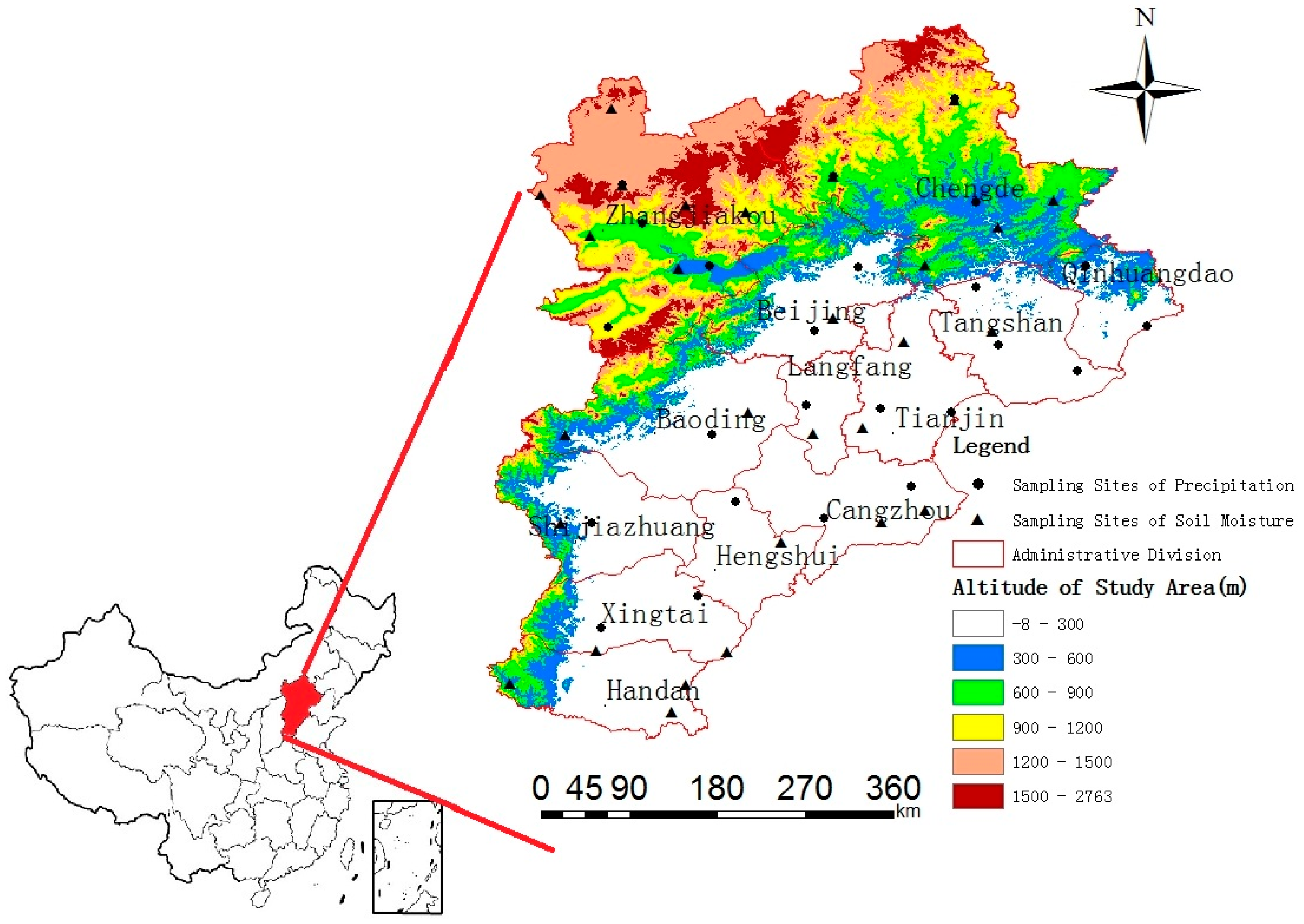



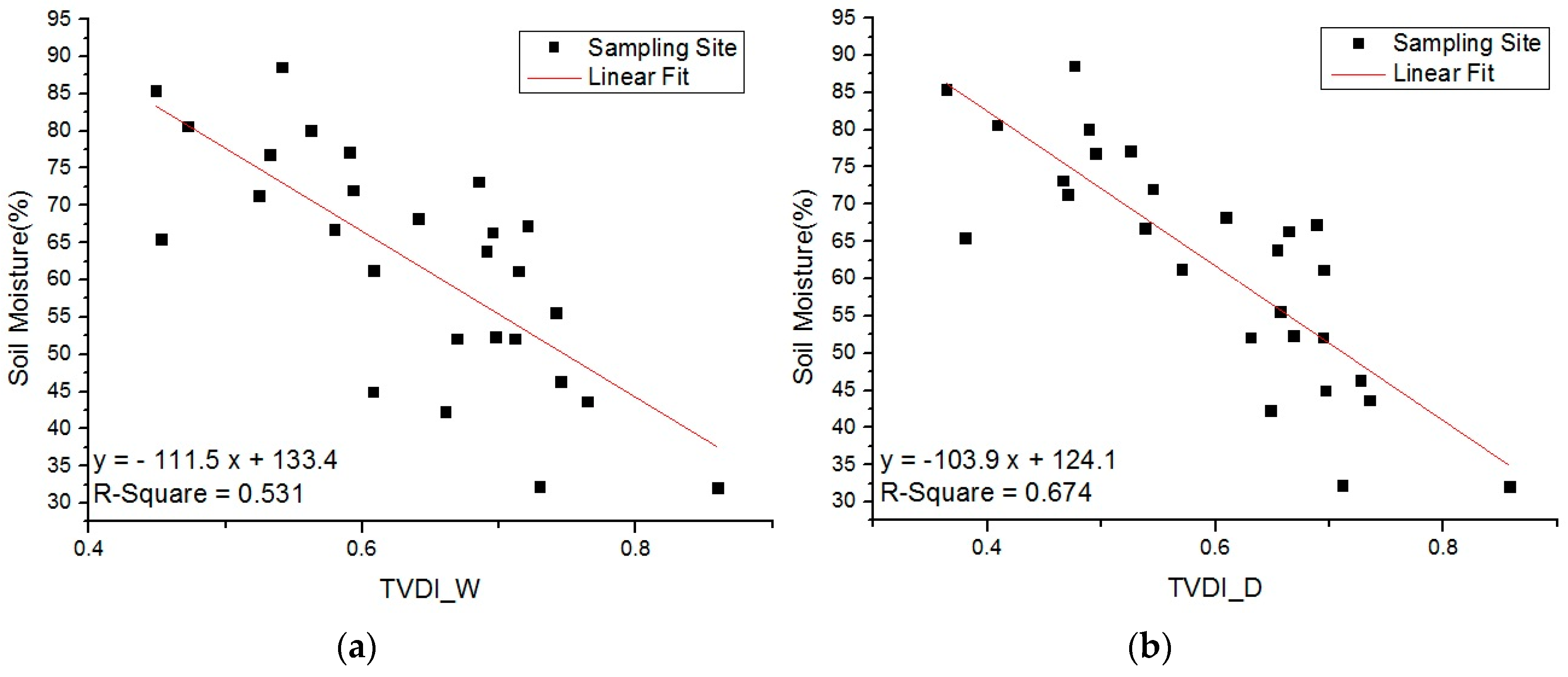
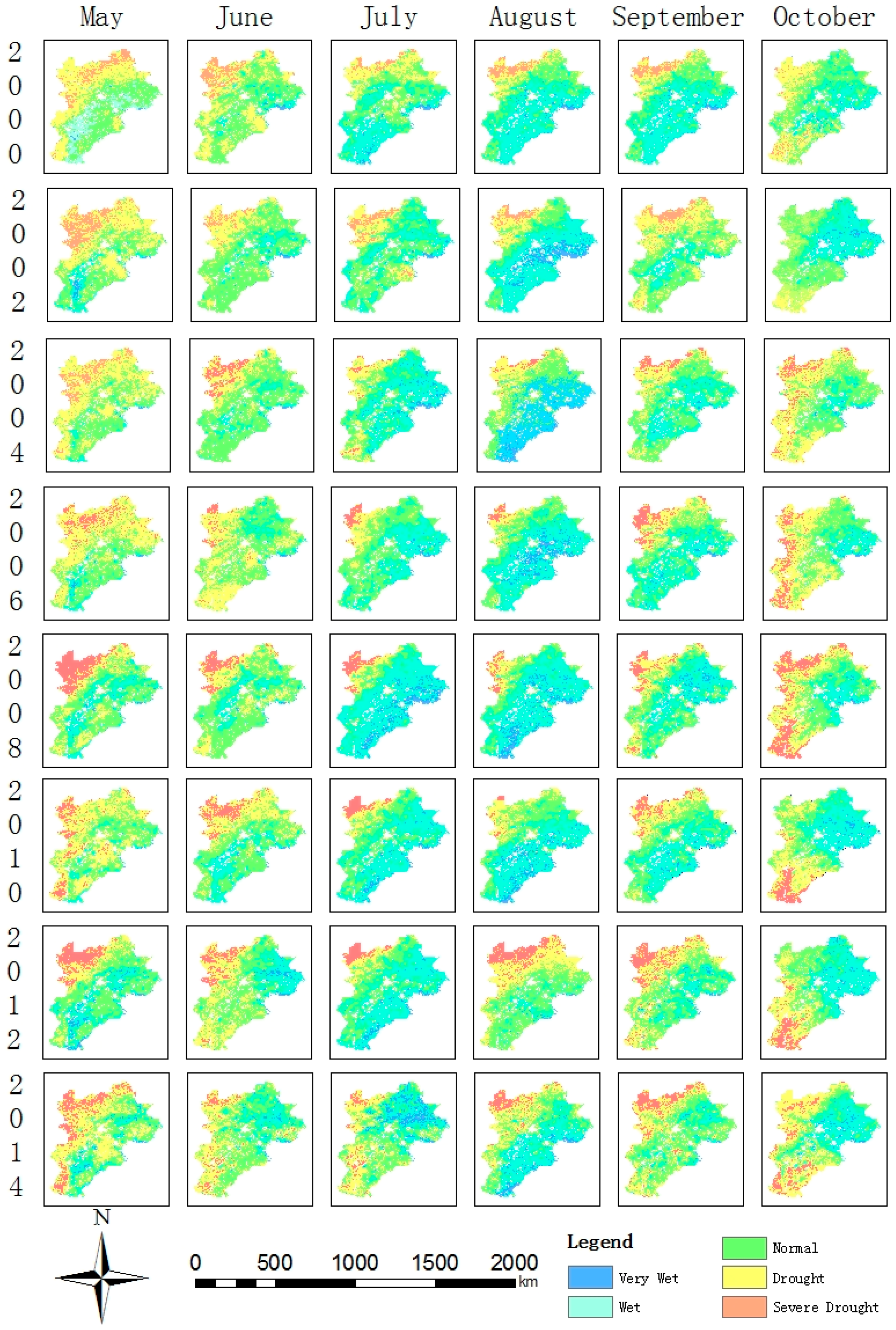



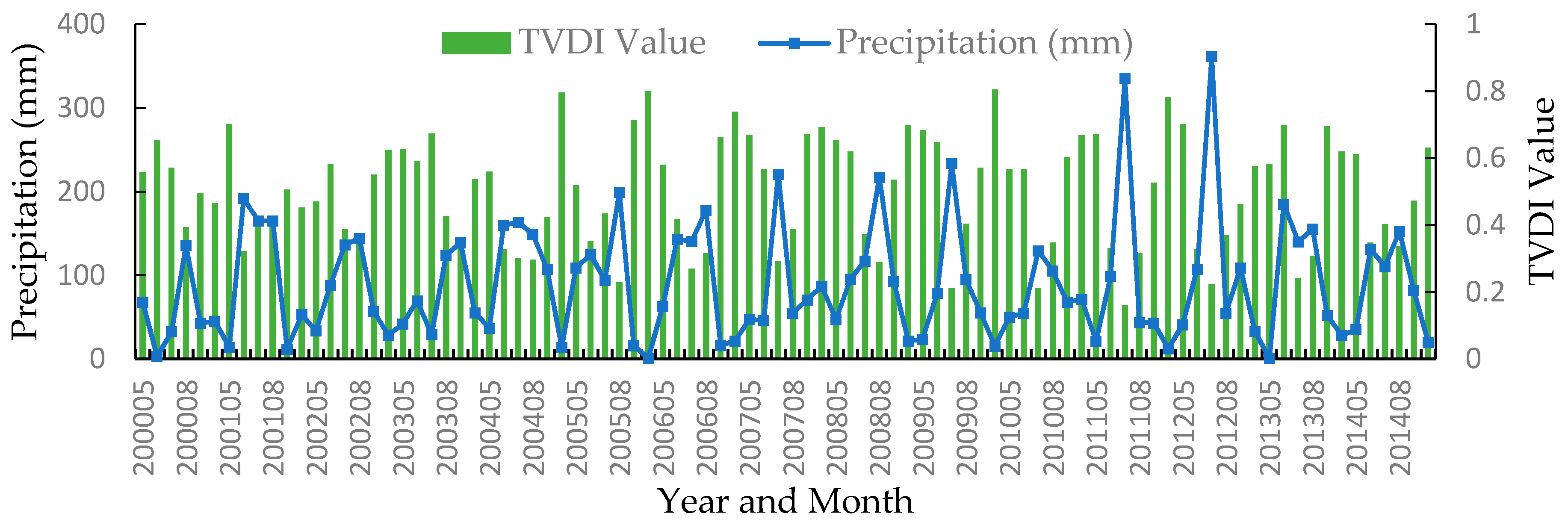

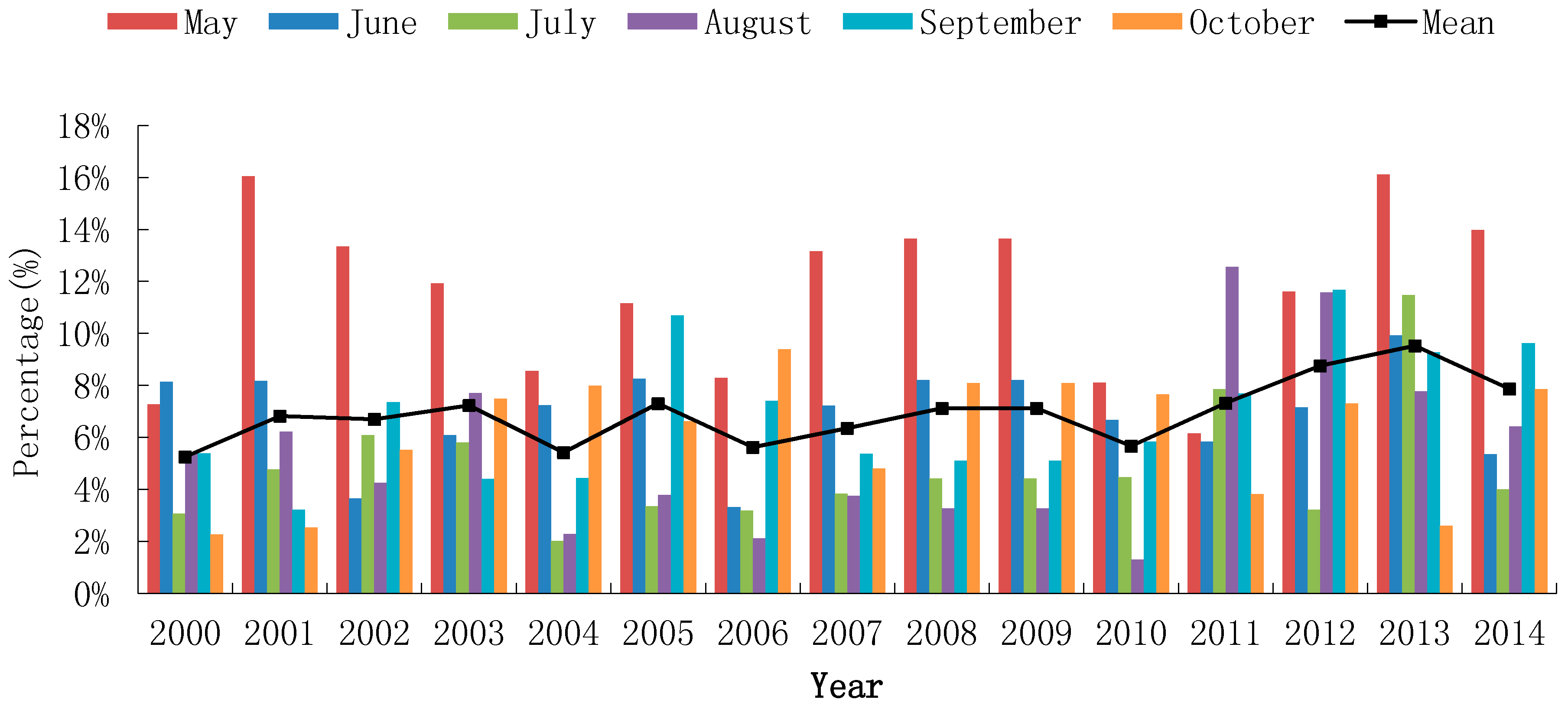
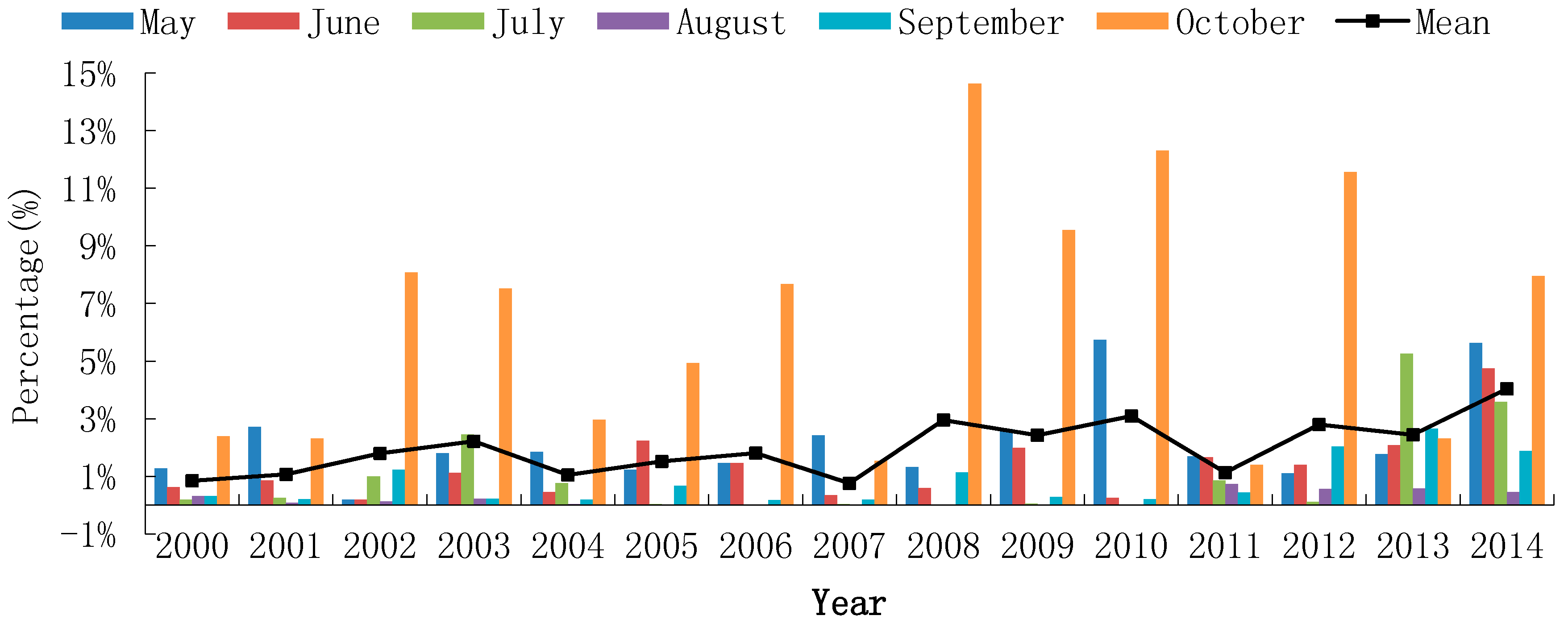

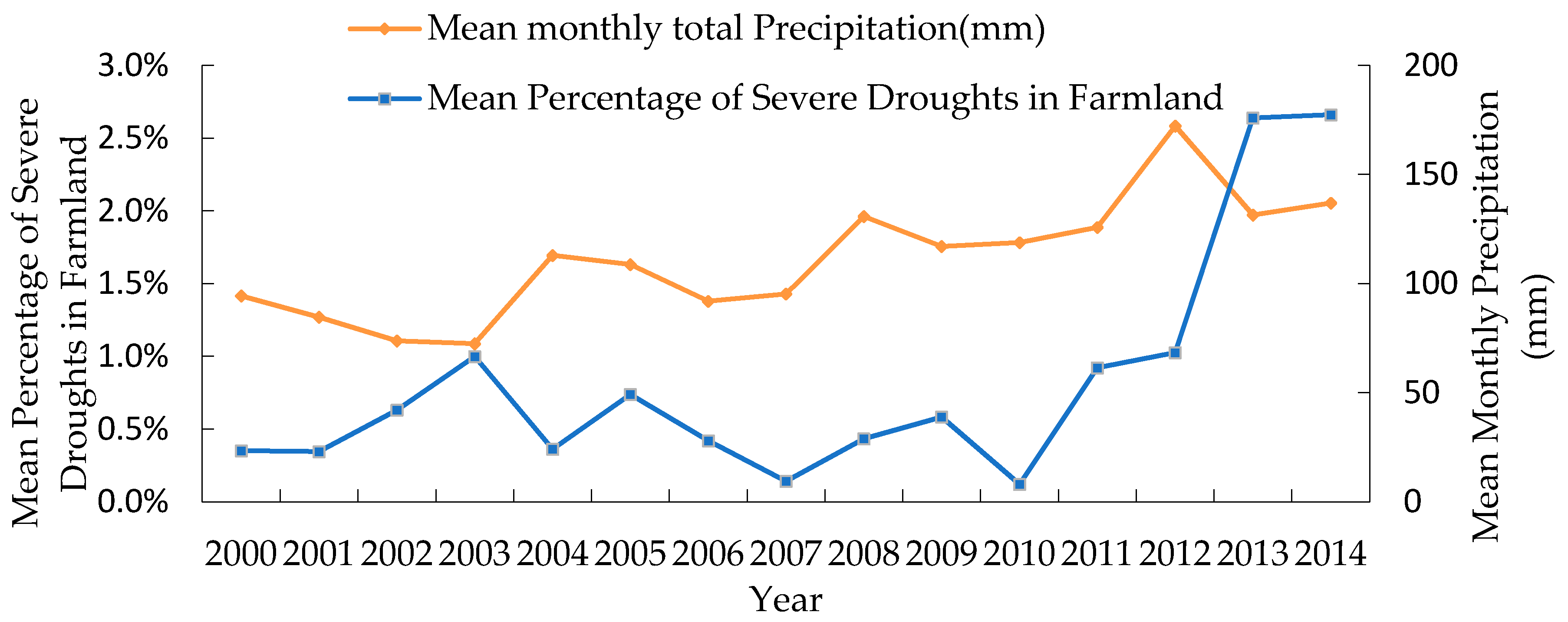
| Type | Dry Edge | Wet Edge |
|---|---|---|
| Whole | LST = −6.51 × NDVI + 317.27 | LST = 2.83 × NDVI + 290.65 |
| Woodland | LST = −2.83 × NDVI + 311.33 | LST = 2.92 × NDVI + 292.23 |
| Cropland | LST = −5.92 × NDVI + 316.77 | LST = 3.42 × NDVI + 292.73 |
| Grassland | LST = −10.86 × NDVI + 318.49 | LST = 5.89 × NDVI + 291.60 |
| Type | NDVI Minimum | NDVI Maximum | LST Minimum | LST Maximum |
|---|---|---|---|---|
| Whole | 0.16 | 0.99 | 294.65 | 314.51 |
| Woodland | 0.41 | 0.97 | 294.65 | 307.94 |
| Farmland | 0.19 | 0.99 | 297.34 | 313.48 |
| Grassland | 0.16 | 0.844 | 300.18 | 314.51 |
© 2016 by the authors; licensee MDPI, Basel, Switzerland. This article is an open access article distributed under the terms and conditions of the Creative Commons Attribution (CC-BY) license (http://creativecommons.org/licenses/by/4.0/).
Share and Cite
Liu, H.; Zhang, A.; Jiang, T.; Lv, H.; Liu, X.; Wang, H. The Spatiotemporal Variation of Drought in the Beijing-Tianjin-Hebei Metropolitan Region (BTHMR) Based on the Modified TVDI. Sustainability 2016, 8, 1327. https://doi.org/10.3390/su8121327
Liu H, Zhang A, Jiang T, Lv H, Liu X, Wang H. The Spatiotemporal Variation of Drought in the Beijing-Tianjin-Hebei Metropolitan Region (BTHMR) Based on the Modified TVDI. Sustainability. 2016; 8(12):1327. https://doi.org/10.3390/su8121327
Chicago/Turabian StyleLiu, Haixin, Anbing Zhang, Tao Jiang, Haitao Lv, Xinxia Liu, and Hefeng Wang. 2016. "The Spatiotemporal Variation of Drought in the Beijing-Tianjin-Hebei Metropolitan Region (BTHMR) Based on the Modified TVDI" Sustainability 8, no. 12: 1327. https://doi.org/10.3390/su8121327





